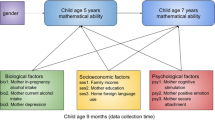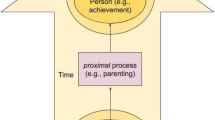Abstract
There is substantial evidence of the association between multiple parental involvement and mathematical performance, but the long-term features of these links remain unclear, in particular in China. This study investigated the 8-year trajectory of mathematical performance, and its associations with five forms of parental involvement. The sample consisted of 645 adolescents (50.39% girls; Mage = 10.5 years, SD = 0.50). Latent growth curve modeling showed upward linear growth in mathematics performance. Among five forms of parental involvement, parental educational expectation was the most powerful predictor. Gender differences and similarities were also found in the family-education nexus. The parental expectation was positively associated with their initial performance in mathematics across gender. The predicting roles of parent-child discussion about school and parental TV controls on the baseline level of mathematical performance and the association between parental expectation and the slope of mathematical performance were only identified among boys. This study highlighted the varied impacts of parental involvement on schooling at different developmental stages, and provided important implications for optimizing parenting and schooling.


Similar content being viewed by others
Notes
Additional forms of parental involvement (e.g. parents’ rules regarding TV program selection) were excluded from this study in CFPS due to their similarities to the selected variables.
References
Almroth, M., László, K. D., Kosidou, K., & Galanti, M. R. (2020). Individual and familial factors predict formation and improvement of adolescents’ academic expectations: A longitudinal study in Sweden. PLoS ONE, 15(2), e0229505. https://doi.org/10.1371/journal.pone.0229505
Boonk, L., Gijselaers, H. J. M., Ritzen, H., & Brand-Gruwel, S. (2018). A review of the relationship between parental involvement indicators and academic achievement. Educational Research Review, 24, 10–30. https://doi.org/10.1016/j.edurev.2018.02.001
Davis-Kean, P. E. (2005). The influence of parent education and family income on child achievement: The indirect role of parental expectations and the home environment. Journal of Family Psychology, 19(2), 294–304. https://doi.org/10.1037/0893-3200.19.2.294
Ding, C. S., Song, K. I. M., & Richardson, L. I. (2006). Do mathematical gender differences continue? A longitudinal study of gender difference and excellence in mathematics performance in the U.S. Educational Studies, 40(3), 279–295. https://doi.org/10.1080/00131940701301952
Epstein, J. L. (1986). Parents’ reactions to teacher practices of parent involvement. The Elementary School Journal, 86(3), 277–294. https://doi.org/10.1086/461449
Fan, X. (2001). Parental involvement and students’ academic achievement: A growth modeling analysis. The Journal of Experimental Education, 70(1), 27–61. https://doi.org/10.1080/00220970109599497
Fan, X., & Chen, M. (2001). Parental involvement and students’ academic achievement: A meta-analysis. Educational Psychology Review, 13(1), 1–22. https://doi.org/10.1023/A:1009048817385
Guo, X., Lv, B., Zhou, H., Liu, C., Liu, J., Jiang, K., & Luo, L. (2018). Gender differences in how family income and parental education relate to reading achievement in China: The mediating role of parental expectation and parental involvement. Frontiers in Psychology, 9(783). https://doi.org/10.3389/fpsyg.2018.00783
Hill, N. E., & Tyson, D. F. (2009). Parental involvement in middle school: A meta-analytic assessment of the strategies that promote achievement. Developmental Psychology, 45(3), 740–763
Hong, S., & Ho, H.-Z. (2005). Direct and indirect longitudinal effects of parental involvement on student achievement: Second-order latent growth modeling across ethnic groups. Journal of Educational Psychology, 97, 32–42. https://doi.org/10.1037/0022-0663.97.1.32
Hong, S., Yoo, S.-K., You, S., & Wu, C.-C. (2010). The reciprocal relationship between parental involvement and mathematics achievement: Autoregressive cross-lagged modeling. The Journal of Experimental Education, 78(4), 419–439. https://doi.org/10.1080/00220970903292926
Hu, L.-T., & Bentler, P. M. (1999). Cutoff criteria for fit indexes in covariance structure analysis: Conventional criteria versus new alternatives. Structural Equation Modeling: A Multidisciplinary Journal, 6(1), 1–55
Institute of Social Science Survey. (2013). Cfps public data. https://www.isss.pku.edu.cn/cfps/en/data/public/index.htm
Jeynes, W. H. (2007). The relationship between parental involvement and urban secondary school student academic achievement—A meta-analysis. Urban Education, 42(1), 82–110. https://doi.org/10.1177/0042085906293818
Kim, S. W. (2020). Meta-analysis of parental involvement and achievement in East Asian countries. Education and Urban Society, 52(2), 312–337. https://doi.org/10.1177/0013124519842654
Kim, S. W., & Fong, V. L. (2014). Homework help, achievement in middle school, and later college attainment in China. Asia Pacific Education Review, 15(4), 617–631. https://doi.org/10.1007/s12564-014-9350-9
Kline, R. B. (2011). Principles and practices of structural equation modeling (3rd ed.). Guilford Press
Levine, S. C., & Pantoja, N. (2021). Development of children’s math attitudes: Gender differences, key socializers, and intervention approaches. Developmental Review, 62, 100997
Li, G., Li, B., Wang, L., Liu, C., & Lu, L. (2022). A longitudinal study on the impact of parental academic support and expectations on students’ academic achievement: The mediating role of happiness. European Journal of Psychology of Education. https://doi.org/10.1007/s10212-022-00608-x
Li, Y., Hu, T. T., Ge, T. S., & Auden, E. (2019). The relationship between home-based parental involvement, parental educational expectation and academic performance of middle school students in Mainland China: A mediation analysis of cognitive ability. International Journal of Educational Research, 97, 139–153. https://doi.org/10.1016/j.ijer.2019.08.003
Little, J. A. R. (1988). A test of missing completely at random for multivariate data with missing values. Journal of the American Statistical Association, 83(404), 1198–1202. https://doi.org/10.2307/2290157
Liu, A., & Xie, Y. (2015). Influences of monetary and non-monetary family resources on children’s development in verbal ability in China. Research in Social Stratification and Mobility, 40, 59–70. https://doi.org/10.1016/j.rssm.2015.02.003
Lv, B., Lv, L., Yan, Z., & Luo, L. (2019). The relationship between parental involvement in education and children’s academic/emotion profiles: A person-centered approach. Children and Youth Services Review, 100, 175–182. https://doi.org/10.1016/j.childyouth.2019.03.003
Matsuoka, R. (2014). An empirical investigation of relationships between junior high school students’ family socioeconomic status, parental involvement, and academic performance in Japan. Sociological Theory and Methods, 29(1), 147–165. https://doi.org/10.11218/ojjams.29.147
McNeal, R. B. (2012). Checking in or checking out? Investigating the parent involvement reactive hypothesis. The Journal of Educational Research, 105(2), 79–89. https://www.jstor.org/stable/26586911
Mejias, P. P., McAllister, D. E., Diaz, K. G., & Ravest, J. (2021). A longitudinal study of the gender gap in mathematics achievement: Evidence from Chile. Educational Studies in Mathematics, 107(3), 583–605. https://doi.org/10.1007/s10649-021-10052-1
Mok, M. M. C., McInerney, D. M., Zhu, J. X., & Or, A. (2015). Growth trajectories of mathematics achievement: Longitudinal tracking of student academic progress. British Journal of Educational Psychology, 85(2), 154–171. https://doi.org/10.1111/bjep.12060
Muthén, L. K., & Muthén, B. O. (2017). Mplus user’s guide. Muthén & Muthén
OECD. (2016). PISA 2015 results (Volume II): Excellence and equity in education. OECD. https://www.oecd-ilibrary.org/education/pisa-2015-results-volume-i/gender-differences-in-mathematics-performance_9789264266490-graph70-en
Park, H., Byun, S.-Y., & Kim, K.-K. (2011). Parental involvement and students’ cognitive outcomes in Korea: Focusing on private tutoring. Sociology of Education, 84(1), 3–22. https://doi.org/10.1177/0038040710392719
Patall, E. A., Cooper, H., & Robinson, J. C. (2008). Parent involvement in homework: A research synthesis. Review of Educational Research, 78(4), 1039–1101. https://doi.org/10.3102/0034654308325185
Pinquart, M., & Ebeling, M. (2020). Parental educational expectations and academic achievement in children and adolescents—A meta-analysis. Educational Psychology Review, 32(2), 463–480. https://doi.org/10.1007/s10648-019-09506-z
Pomerantz, E. M., Moorman, E. A., & Litwack, S. D. (2007). The how, whom, and why of parents’ involvement in children’s academic lives: More is not always better. Review of Educational Research, 77(3), 373–410. https://doi.org/10.3102/003465430305567
Pope Edwards, C., & Bloch, M. (2010). The Whitings’ concepts of culture and how they have fared in contemporary psychology and anthropology. Journal of Cross-Cultural Psychology, 41(4), 485–498. https://doi.org/10.1177/0022022110362566
Seginer, R. (2006). Parents’ educational involvement: A developmental ecology perspective. Parenting-Science and Practice, 6(1), 1–48. https://doi.org/10.1207/s15327922par0601_1
Strayhorn, T. L. (2010). The role of schools, families, and psychological variables on math achievement of black high school students. The High School Journal, 93(4), 177–194
Teuber, Z., Tang, X., Sielemann, L., Otterpohl, N., & Wild, E. (2022). Autonomy-related parenting profiles and their effects on adolescents’ academic and psychological development: A longitudinal person-oriented analysis. Journal of Youth and Adolescence, 51(7), 1333–1353. https://doi.org/10.1007/s10964-021-01538-5
Tian, L., Li, X., Chen, X., & Huebner, E. S. (2023). Gender-specific trajectories of academic achievement in Chinese elementary school students: Relations with life satisfaction trajectories and suicidal ideation trajectories. Learning and Instruction, 85, 101751. https://doi.org/10.1016/j.learninstruc.2023.101751
van der Vleuten, M., Jaspers, E., Maas, I., & van der Lippe, T. (2016). Boys’ and girls’ educational choices in secondary education. The role of gender ideology. Educational Studies, 42(2), 181–200. https://doi.org/10.1080/03055698.2016.1160821
Van Voorhis, F. L. (2011). Adding families to the homework equation: A longitudinal study of mathematics achievement. Education and Urban Society, 43(3), 313–338. https://doi.org/10.1177/0013124510380236
Wang, H., Chen, Y., Yang, X., Yu, X., Zheng, K., Lin, Q., Cheng, X., & He, T. (2023a). Different associations of parental involvement with children’s learning of Chinese, English, and math: A three-wave longitudinal study. European Journal of Psychology of Education, 38(1), 269–285. https://doi.org/10.1007/s10212-022-00605-0
Wang, J., Chen, C., & Gong, X. M. (2021). The impact of family socioeconomic status and parenting styles on children’s academic trajectories: A longitudinal study comparing migrant and urban children in China. Child & Adolescent Development, 176, 81–102. https://doi.org/10.1002/cad.20394
Wang, Z., Liu, F., & Julkunen, I. (2023b). Diversifying youth temporal orientations during educational transitions in China. Children & Society, 1–15. https://doi.org/10.1111/chso.12733
Wei, T., Liu, X., & Barnard-Brak, L. (2015). Gender differences in mathematics and reading trajectories among children from kindergarten to eighth grade. Research in Education, 93, 77–89. https://doi.org/10.7227/RIE.0015
Whiting, B. B., & Whiting, J. W. M. (1975). Children of six cultures: A psycho-cultural analysis. Harvard University Press
Wilder, S. (2014). Effects of parental involvement on academic achievement: A meta-synthesis. Educational Review, 66(3), 377–397. https://doi.org/10.1080/00131911.2013.780009
Xiong, Y., Qin, X., Wang, Q., & Ren, P. (2021). Parental involvement in adolescents’ learning and academic achievement: Cross-lagged effect and mediation of academic engagement. Journal of Youth and Adolescence, 50(9), 1811–1823. https://doi.org/10.1007/s10964-021-01460-w
Yamamoto, Y., & Holloway, S. D. (2010). Parental expectations and children’s academic performance in sociocultural context. Educational Psychology Review, 22(3), 189–214. https://doi.org/10.1007/s10648-010-9121-z
Zhang, Y., Cui, C., He, Y., & Wang, L. (2022). Does private supplementary tutoring matter in Chinese students’ learning of mathematics: A longitudinal study. ZDM – Mathematics Education, 54(3), 737–747. https://doi.org/10.1007/s11858-022-01346-6
Zhang, Y., Dang, Y., He, Y., Ma, X., & Wang, L. (2021). Is private supplementary tutoring effective? A longitudinally detailed analysis of private tutoring quality in China. Asia Pacific Education Review, 22(2), 239–259. https://doi.org/10.1007/s12564-021-09671-3
Zhu, J., & Chiu, M. M. (2019). Early home numeracy activities and later mathematics achievement: Early numeracy, interest, and self-efficacy as mediators. Educational Studies in Mathematics, 102(2), 173–191. https://doi.org/10.1007/s10649-019-09906-6
Acknowledgements
The authors thank Lv, Nan for his feedback on this article.
Funding
This work was supported by the Fundamental Research Funds for the Central Universities and the Research Funds of Renmin University of China (22XNF040) to Z.W.; X.T. also received supports from Shanghai Pujiang Program (grant number 22PJC057).
Data Sharing and DeclarationThe datasets generated and/or analyzed during the current study are available in the China Family Panel Studies, https://www.isss.pku.edu.cn/cfps/en/data/public/index.htm.
Author information
Authors and Affiliations
Contributions
Z.W. proposed the research idea, conceptually designed the study, performed statistical analysis, interpreted the results, and drafted and revised the manuscript; X.T. proposed the research idea, conceptually designed the study, supervised the analyses, interpreted the results, and revised the manuscript. All authors read and approved the final manuscript.
Corresponding author
Ethics declarations
Conflict of Interest
The authors declare no competing interests.
Ethical Approval
The present study is based on secondary data analysis of publicly available data, the study is exempt from ethical consent considerations.
Informed Consent
Participation was voluntary, and informed consent forms were collected from the students and their parents by China Family Panel Studies project.
Additional information
Publisher’s note Springer Nature remains neutral with regard to jurisdictional claims in published maps and institutional affiliations.
Appendix A
Appendix A
Rights and permissions
Springer Nature or its licensor (e.g. a society or other partner) holds exclusive rights to this article under a publishing agreement with the author(s) or other rightsholder(s); author self-archiving of the accepted manuscript version of this article is solely governed by the terms of such publishing agreement and applicable law.
About this article
Cite this article
Wang, Z., Tang, X. Developmental Trajectories in Mathematical Performance Among Chinese Adolescents: The Role of Multi-Dimensional Parental Involvement. J. Youth Adolescence 53, 877–894 (2024). https://doi.org/10.1007/s10964-023-01893-5
Received:
Accepted:
Published:
Issue Date:
DOI: https://doi.org/10.1007/s10964-023-01893-5




